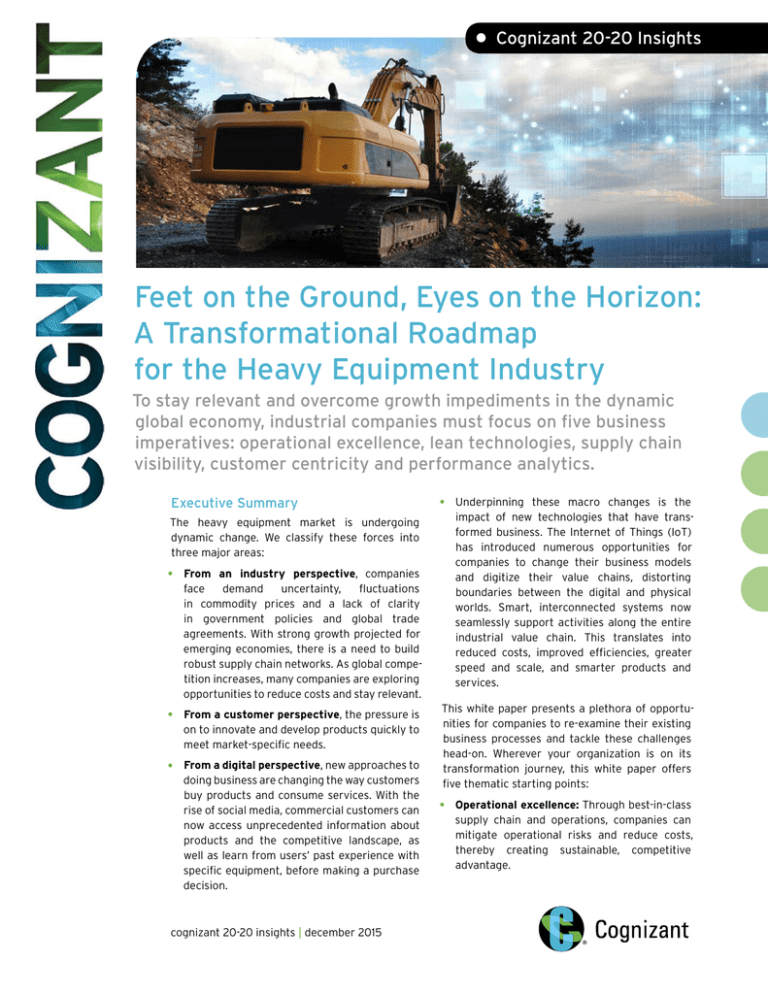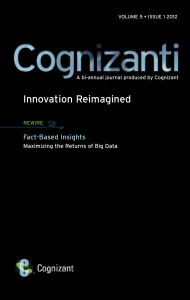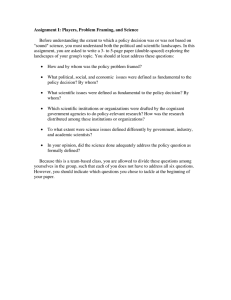
• Cognizant 20-20 Insights
Feet on the Ground, Eyes on the Horizon:
A Transformational Roadmap
for the Heavy Equipment Industry
To stay relevant and overcome growth impediments in the dynamic
global economy, industrial companies must focus on five business
imperatives: operational excellence, lean technologies, supply chain
visibility, customer centricity and performance analytics.
Executive Summary
•
The heavy equipment market is undergoing
dynamic change. We classify these forces into
three major areas:
•
From an industry perspective, companies
face
demand
uncertainty,
fluctuations
in commodity prices and a lack of clarity
in government policies and global trade
agreements. With strong growth projected for
emerging economies, there is a need to build
robust supply chain networks. As global competition increases, many companies are exploring
opportunities to reduce costs and stay relevant.
•
From a customer perspective, the pressure is
on to innovate and develop products quickly to
meet market-specific needs.
•
From a digital perspective, new approaches to
doing business are changing the way customers
buy products and consume services. With the
rise of social media, commercial customers can
now access unprecedented information about
products and the competitive landscape, as
well as learn from users’ past experience with
specific equipment, before making a purchase
decision.
cognizant 20-20 insights | december 2015
Underpinning these macro changes is the
impact of new technologies that have transformed business. The Internet of Things (IoT)
has introduced numerous opportunities for
companies to change their business models
and digitize their value chains, distorting
boundaries between the digital and physical
worlds. Smart, interconnected systems now
seamlessly support activities along the entire
industrial value chain. This translates into
reduced costs, improved efficiencies, greater
speed and scale, and smarter products and
services.
This white paper presents a plethora of opportunities for companies to re-examine their existing
business processes and tackle these challenges
head-on. Wherever your organization is on its
transformation journey, this white paper offers
five thematic starting points:
•
Operational excellence: Through best-in-class
supply chain and operations, companies can
mitigate operational risks and reduce costs,
thereby creating sustainable, competitive
advantage.
•
Lean technology landscape: Having a lean
technology landscape from an IT perspective
can increase employee productivity, improve
business processes and reduce costs.
•
Global supply chain visibility: With better
visibility, companies can track sales, products
and components up to the final destination
through availability of real-time data.
•
Customer-centric innovation: This will be
driven through implementation of systems
that enrich the customer experience through
customer process-driven innovation.
•
Performance and analytics: A strong analytics
backbone can help companies identify opportunities to not only strengthen their decisionmaking capabilities but also improve partner
and supplier performance effectiveness.
ties for equipment sales.10 New technologies are
driving demand for equipment replacement, as
the enhanced efficiency often increases the economic feasibility of more frequent replacement of
equipment.11 We believe the following imperatives are needed
for heavy equipment companies to successfully
respond to these market forces.
•
Focus on growth through emerging markets:
With countries such as China and India
exhibiting steady economic growth, industrial
equipment makers need to provide customized
solutions to smaller farmers and provide them
with attractive finance schemes to increase
equipment affordability.
•
Build a world-class distribution network:
To enter emerging markets, it is essential
for companies to understand their supply
chains and build a strong distribution network,
customized to specific regions. Measures must
also be in place to mitigate risk and ensure
order fulfillment capabilities across locations.
The Heavy Equipment Marketplace
The heavy equipment market comprises three
industries: agricultural machinery (sized at about
$126 billion in 20131), construction equipment
(valued at $138.5 billion in 20122) and mining
equipment (valued at $71 billion in 20123).
Global demand for agricultural equipment is
forecast to expand 6.9% annually through 2018,
to $208 billion.4 The Asia/Pacific region, which
accounted for almost half (46%) of agricultural
equipment demand worldwide in 2013,5 according to the latest figures available, represents the
largest and fastest growing regional market.6 In
more developed markets, such as the U.S. and
Western Europe, growth in agricultural equipment
demand will be driven by efforts to reduce inputs
and maximize production capabilities through the
use of increasingly advanced high-value precision
farming technologies, such as global positioning
systems and yield monitors.7
• Sell smart products and services: Customers
want to optimize their resources and maximize
their returns. Therefore, companies need
to offer solutions that remotely monitor
equipment performance and usage patterns,
as well as generate reports that will provide
customers with real-time visibility into their
daily activities and assist them in running their
business more efficiently.
•
Forces Impacting the Industry
Industry advances are being propelled by the
growth of developing economies, government
support, access to capital and increasing mechanization of farming operations in developing
countries, with particularly sizable gains anticipated in China, India and Brazil.8
Ongoing economic expansion, population growth
and rising per capita calorie intake in these and
other developing nations is boosting demand
for food.9 This will not only place greater pressure on agricultural sectors to boost efficiency
and productivity, but it will also increase farm
incomes, thus creating additional opportuni-
cognizant 20-20 insights
Develop a 360-degree customer perspective: Companies must understand customers
holistically by gathering local data, ensuring
and sustaining customer engagement through
quality content and addressing their issues
immediately by putting early-warning systems
in place. This will boost customer confidence
and the company’s reputation.
Competitive View
The global market is dominated by large multinational players, such as Caterpillar, CNH, Deere &
Co., Komatsu, AGCO, Kubota, etc. These players
have large, diversified business portfolios, selling products and services in construction and
agriculture. Business diversification helps these
companies mitigate market risk and ensure
they are not overly dependent on one specific
industry. All these companies have a global focus,
and some sell their equipment under different
brand names and with a specific regional and
product focus.
2
To understand how the market performed, we
analyzed the key efficiency ratios for the past
10 years of multinational players such as John
Deere, Komatsu, CNH, AGCO and Caterpillar. Our
observation is that the industry growth has tilted
to the negative side of the ledger;12 in fact growth
has been significantly lower for companies with
mining exposure such as CAT.13 Competition has
also impacted profit margins, while revenues
remained flat for 2013-2014.14 From our below
analysis, we have observed trends in certain
areas, indicating opportunities for improved operations and efficiencies.
•
Cash conversion cycle: This has exponentially increased for multiple companies over
the years, indicating that cash is tied up in
the business, impacting the bottom line. For
example, Deere’s cash conversion ratio has
risen about 2,000% since 2005.15
•
Days in inventory: An increase in days in
inventory indicates a company is taking more
time to convert its finished goods into sales.
For example, Komatsu’s days in inventory has
risen by almost 60% since 2004.16
• Asset
turnover ratio: All companies studied
have generated less revenue per dollar of
asset, with the ratio deteriorating between
2011 and 2014. This signifies excess production
and poor inventory management. Stagnating
sales growth over the past few years has also
negatively impacted these ratios. For example,
CAT has seen a 20% reduction in asset turnover
since 2005.17
These trends could be primarily attributed to
deceleration in the U.S. and EU markets, and a
slow shift of focus from mature markets to emerging markets. They also highlight the need for
effective distribution networks that can aggressively enter new markets, increase customer
focus and provide customized solutions that add
value to client relationships. Inventory levels
have also built up over the years, indicating the
potential to improve supply chain management.
Measuring Digital Footprints
The rise of technology platforms has put manufacturers in the driver’s seat. Companies are
improving their ability to develop their own technology platforms that offer real-time information
Correlating Business Mandates with Needs
IMPERATIVES
CAPABILITIES
Industry view
• Focus on cost reduction and maintaining competitiveness.
• Accelerated emphasis on global growth through
emerging markets.
• Focus on exceptional quality and innovative
products to capture market share.
• Utilize innovative ways of working to gain better
business and customer insights.
Digital technology view
• Digitization of value chain through IoT, thereby
transforming operations processes.
• Smarter connected products — telematics and
remote diagnostics.
• Rise of technology platforms, mobile devices and
social media offering real-time information to
customers.
Customer view
• Shift in customer need from products and services
to outcomes.
• Need for customized online content to manage
sentiment and enrich user experience.
• Need for intelligent products that reduce TCO and
provide quick ROI.
Figure 1
cognizant 20-20 insights
3
Operational excellence
Achieve operational excellence
through best-in-class supply
chain and operations.
Lean technology landscape
Make the existing technology
landscape lean and mean.
Global supply chain visibility
Build global visibility capabilities to stay on top of operations.
Customer-centric innovation
Use innovation to improve
customer touchpoints.
Performance and analytics
Build a strong analytics
backbone designed for the
future.
2
#
about farms, machines, equipment health monitoring, fleet management and area harvested.
Platforms such as MyJohnDeere18 provide the
blueprint for how companies will forge new value
chains on the fly to build, connect and deliver
applications specific to industry problems.
With Internet access exploding exponentially, particularly across undeveloped markets, and with
the rise of mobile devices, businesses are now
shifting their focus to creating online marketing
content. Relative to cloud-based transformation,
companies are either creating their own ecosystem (e.g., AGCO’s Open Approach, which is built
on the company’s Fuse™ technology platform19)
or partnering with companies on public platforms
(e.g., CNH as an active member of Open Ag Data
Alliance20) to share cross-industry information
and improve business processes.
With increased use of social media, industrial equipment companies need to find the right
balance of managing reach and content; online
reputation is key, as sentiments in different
channels play an important top-line role. On the
mobile front, only a few customers use mobile
apps for agriculture management. This indicates that companies lack a modern strategy for
understanding customers and their product preferences and need to encourage more use of the
mobile platform.
Key Takeaways
Given the industry’s historical performance, there
are many lessons to learn from companies in
other industries.
•
Deeper
contextual
understanding
of
customers helps capture greater revenue and
improves operational effectiveness. Managing
big data will help businesses gain insights.
• Seamless
integration of digital and physical
supply chains can deliver comprehensive
solutions for customers.
•
Cross-industry collaboration and integrated
partners in the supply chain will help advance
business process improvement and decisionmaking.
• Smart products and the IoT can be leveraged
for performance monitoring across the value
chain to improve customer relationships and
conduct remote diagnostics or aftermarket
services.
Capabilities Surfaced by an Effective
Transformation Roadmap
Based on the aforementioned trends, it is clear
that the industry needs to increase its focus on
growth and efficiency imperatives. Figure 1 (previous page) highlights five capabilities that are
essential to streamlining operations, reducing
costs, understanding customer needs, driving
sales growth and sustaining leadership.
Capability #1: Operational Excellence
This is a key capability that industrial equipment
players must adopt to execute their business
strategy with consistency and reliability. Through
best-in-class supply chain and operational strategies, companies can mitigate risk and reduce
costs, thereby creating a sustainable competitive
advantage. Figure 2 reveals how organizations
can achieve operational excellence.
Attaining Operational Excellence (continued on next page)
Transformation Approach
Procurement risk management
How It Works
Helps standardize supplier
risk assessments and contract
management processes; enables
creation of a single online
repository for vendor and supplier
due diligence and contracts.
Figure 2
cognizant 20-20 insights
4
Example
In March 2015, AGCO was
awarded for actualizating
innovation in e-procurement
by rolling out a global
procurement transformation
effort in its materials and
supplier management function.
The company enabled global
commodity managers and buyers
to pool their experiences and
activities to make decisions
based on greater visibility into
supplier performance, as well as
identify and assess economic,
geopolitical and other risks.21
Attaining Operational Excellence (continued)
Transformation Approach
Dealer sales incentive
management
How It Works
Example
Provides a one-stop solution for
all sales incentive management
tracking by enabling incentive
planning, execution (e.g., marketing
campaigns,
promotions)
and
collaboration.
Caterpillar wants its dealers
to move more customers into
equipment management solutions.
By installing cameras, sensors and
satellite-based positioning control
and guidance systems on its
machines, Caterpillar believes its
dealers can use this information
to increase parts and service sales,
and help customers manage their
fleets more efficiently.22
Accurately estimates order
fulfillment across locations and
enables companies to ”make
anywhere” and “sell anywhere.”
Example: Texas-based
Commercial Metals Company
(CMC) implemented GATP
in its U.S. and international
operations, eliminating duplicate
work in its fabrication shops
when it comes to logistics and
inventory management. GATP
allowed the company to allocate
inventory among different
customers, protect inventory for
priority customers and react to
unforeseen changes in demand.23
Global availability to promise
(GATP)
Figure 2
Capability #2: Lean Technology Landscape
Having a lean technology landscape from an IT perspective can increase employee productivity, improve
business processes and reduce costs. Figure 3 offers ideas on how to implement lean.
Implementing Lean
Transformation Approach
How It Works
Provides an app store-based
approach to delivering employee
services; on-demand data
provisioning can be made easily
available at the click of a button.
We have implemented an
enterprise-wide app store
(One Cognizant) approach that
allows employees to access
multiple apps and other related
content from one location to
perform their jobs better; the
store’s social design encourages
collaboration and sharing with
others performing the same task.
Digitizes back-office processes
(finance, HR, admin) through
electronic workflow management
and approvals, digital signatures
and on-demand reports, reducing
use of paper and boosting efficiency
and productivity.
Volvo in the Netherlands
has implemented e-invoicing
solutions to digitize workflows,
improve financial reporting and
increase the speed of reporting,
thereby supporting faster
decision-making.24
App store
Paperless back office
Example
Figure 3
cognizant 20-20 insights
5
Figure 4
Capability #3: Global Supply Chain Visibility
As supply-demand networks become increasingly
complex and data is available in real time, global
supply chain visibility will allow companies to
more effectively track sales, products and com-
ponents through the final destination. Figure 4
details ways for industrial equipment companies
to move quickly and mitigate risk, thereby allowing them to stay on top of operations.
Enabling Supply Chain Visibility
Transformation Approach
How It Works
Provides last-mile retail point-ofsale visibility for original equipment
and parts.
Craftworks has implemented
software that allows managers
and staff to easily navigate POS
data and inventory at-a-glance.
The company is now able to
gather business intelligence on
new and existing locations and
compare theoretical vs. actual
costs and their impact on the
bottom line.25
Provides a “control tower,” or a
central hub within the supply chain,
that collects real-time data and
provides visibility into supply chain
activities to improve organizational
decision-making. This functionality
can provide near-real-time global
visibility of dealer orders and
supply chain inventory, as well
as predictive alerts that identify
supply and demand bottlenecks
based on available-to-promise (ATP)
capabilities.
CNH has implemented
transportation management
software that has enhanced
the efficiency of inbound
and outbound transportation,
optimized processes and enabled
complete visibility into the
supply chain through analytics
that help the company monitor
and track supply chain metrics
and identify issues.26
Provides global visibility of
inventory stock across the network,
as well as suggestions on order
fulfillment for pending customer
orders.
John Deere’s consumer and
construction equipment division
has successfully implemented
inventory management software
to improve distribution network
responsiveness, reduce order
lead times and increase network
efficiency through warehouse
consolidation, inventory
reduction and cost reduction.27
Retail POS visibility
Global order and inventory
visibility
Example
Dealer inventory visibility
Figure 4
cognizant 20-20 insights
6
Capability #4: Customer-Centric Innovation
To add value to customer relationships, it is essential to understand customer needs and implement
systems that support customer-centric innovation. Figure 5 suggests key transformational
ideas in this space.
Focusing on the Customer
Transformation Approach
How It Works
Enriches customer experience
through digital storefronts and
virtual showrooms. Moreover,
interactive services can enrich
product content on the Web.
AGCO and Mutual Mobile have
formed a strategic relationship
to improve the user experience28
and help consumers find the
right product through mobile
devices and Web interfaces.29
Collects vast amounts of employee
and customer interaction data
(consumption habits, preferences,
etc.) and provides targeted solutions
based on big data analytics.
John Deere collects and
processes massive amounts
of farm data and leverages
this data into the FarmSightTM
platform to remotely monitor
machines and ensure preventive
maintenance, optimize fuel
consumption and output
performance, and deliver
agronomic information to
farmers for better decisionmaking.30
Analyzes customer sentiment to
understand attitudes, opinions
and trends, and identifies primary
influencers within specific social
networks to manage online
reputation.
Among the key initiatives
of Caterpillar’s social media
strategy is a social listening
platform (managed by its
information analytics group)
that provides the business with
insights into customer sentiment
about industry trends, the
company and its competitors.
This data is also used to
develop a 360-degree view of
customers.31
Enables remote monitoring
of equipment usage patterns,
conditions and breakdowns through
a centralized dashboard.
John Deere and AGCO are
beginning to connect not
only farm equipment but also
irrigation systems and soil
and nutrient sources with
information on weather, crop
prices and commodity futures
to optimize overall farm
performance.32
Digital channel management
Big data service personalization
Social media analytics
Example
Connected products
Figure 5
Capability #5: Performance and Analytics
By developing a strong analytics backbone,
industrial equipment companies can identify
opportunities to not only improve their decision-
Figure 6
cognizant 20-20 insights
making but also increase partner and supplier
performance effectiveness. See Figure 6 (next
page) for ideas on how to develop this capability.
7
Enabling Analytics
Transformation Approach
How It Works
Example
Helps collect sourcing and
procurement data from multiple
systems and apply sourcing, spend,
supplier performance and indirect
spend analytics.
AGCO successfully implemented
a solution to connect and
transact business more
efficiently and effectively with its
customers. AGCO has achieved
greater visibility into and control
over its spend, which has fueled
more favorable contracts and
pricing terms.33
How It Works
Example
Provides real-time visibility into
critical business processes through
push-based dashboards and
alerts powered by an event-driven
architecture.
Mercedes-AMG piloted a
real-time quality assurance
platform that harnesses
predictive analytics to optimize
engine-testing processes when
manufacturing its vehicles.34
The ability to correlate historical
test data with sensor data in
real time enables engineers to
identify problems more quickly.35
Performs activities such as
surveying fields, capturing images,
identifying and classifying infected
regions, estimating pesticide
quantity and optimizing pesticide
usage. One such autonomous robot
is eAGROBOT.
To address the aging and
declining population of Japan,
Komatsu wants to revamp the
industry segments it serves
with a robotics revolution. It
aims to automate tractors and
other equipment by 2020 and
to implement over 20 robotic
processes in multiple industries,
including food processing.36
Spend analytics
Transformation Approach
Business activity monitoring
Robotics
Figure 6
The Way Forward
Heavy equipment suppliers have many opportunities to transform their business, especially in
the areas of inventory management, asset management and customer insights. By adopting new
capabilities in operational excellence, lean technology and global supply chain visibility, these
companies can boost process efficiency, improve
product delivery, reduce costs and mitigate risk.
Establishing new approaches to customer centricity, meanwhile, will enable these companies to
gain insight into customer buying behavior, atti-
tudes and trends, and help them develop holistic
view of customers, thereby speeding innovation.
Analytics capabilities will further improve organizational effectiveness and support faster
decision-making. And finally, all these areas of the
business can learn from one another by examining best practices in the industry.
Studying the five key capabilities outlined in this
paper will enable industrial equipment companies
to support global expansion, create a customercentric focus and prepare for unfavorable and
uncertain market situations, thereby ensuring
business relevance and continued viability.
Footnotes
1
Global Agricultural Machinery Industry, http://en.wikipedia.org/wiki/Agricultural_machinery_industry.
2
“Construction Equipment Market Analysis by Product And Segment Forecasts to 2020,” Grand View
Research,
September
2015,
http://www.grandviewresearch.com/industry-analysis/constructionequipment-market-analysis.
3
“Mining Equipment Market Will Reach USD 117.0 Billion by 2018: Transparency Market Research,” PR
Newswire, Oct. 22, 2014, http://www.prnewswire.com/news-releases/mining-equipment-market-willreach-usd-1170-billion-by-2018-transparency-market-research-280051182.html.
cognizant 20-20 insights
8
4
“Global Demand for Agricultural Equipment to Reach $208 Billion,” Farm Equipment, Aug. 5, 2014, http://
www.farm-equipment.com/articles/10687-global-demand-for-agricultural-equipment-to-reach-208-billion.
5
“World Agricultural Equipment Market,” PR Newsire, Nov. 26, 2014, http://www.prnewswire.com/newsreleases/world-agricultural-equipment-market-300001970.html.
6
Ibid.
7
Ibid.
8
“Global Demand for Agricultural Equipment to Reach $208 Billion,” Farm Equipment, Aug. 5, 2014,
http://www.farm-equipment.com/articles/10687-global-demand-for-agricultural-equipment-toreach-208-billion.
9
Ibid.
10
Ibid.
11
“World Agricultural Equipment Market,” PR Newswire, Nov. 26, 2014, http://www.prnewswire.com/newsreleases/world-agricultural-equipment-market-300001970.html.
12
Cognizant analysis of key financial ratios based on data from “Morningstar” for companies such as Deere,
CNH, CAT, Komatsu, AGCO.
13
Ibid.
14
Ibid.
15
Key ratio analysis for Deere & Co., Morningstar, http://financials.morningstar.com/ratios/r.html?t=DE.
16
Key ratio analysis for Komatsu Ltd., Morningstar, http://financials.morningstar.com/ratios/r.html?t=KMTUY.
17
Key ratio analysis for Caterpillar, Inc., Morningstar, http://financials.morningstar.com/ratios/r.html?t=CAT.
18
“John Deere Opens the MyJohnDeere Platform to Collaborating Software Developers and Companies,”
John Deere, Nov. 14, 2013, https://www.deere.com/en_US/corporate/our_company/news_and_media/
press_releases/2013/corporate/2013nov14_corporaterelease.page.
19
“Taking an Open Approach Leads to New Partnerships,” AGCO, April 10, 2014, http://www.agcotechnologies.com/news/article/taking-an-open-approach-leads-to-new-partnerships/.
20
Open Ag Data Alliance website, http://openag.io/about-us/.
21
“AGCO and riskmethods Win BME Award for Electronic Procurement,” Spend Matters, March 30, 2015,
https://spendmatters.com/2015/03/30/agco-and-riskmethods-wins-bme-award-for-electronic-procurement/.
22
James B. Kelleher, “Caterpillar: Our Dealers Are Missing Up To $18 Billion In Easy Sales,” Business Insider,
March 20, 2014, http://www.businessinsider.com/r-insight-from-dumb-iron-to-big-data-caterpillars-dealer-sales-push-2014-20?IR=T.
23
Todd Morrison, “Manufacturer Consolidates Supply Chain Silos with SAP GATP,” TechTarget, Aug. 26,
2011, http://searchsap.techtarget.com/news/2240069639/Manufacturer-consolidates-supply-chain-siloswith-SAP-GATP.
24
“Volvo Cars Netherlands Uses Anachron Corporate E-Invoicing Platform to Digitize Workflows and
Improve Financial Reporting,” Anachron, Dec. 18, 2014, http://www.anachron.com/volvo-cars-netherlandsuses-anachron-corporate-e-invoicing-platform-digitize-workflows-improve-financial-reporting-2/.
25
“Craftworks Restaurants: Success Story,” Ctuit, Sept. 4, 2012, http://www.ctuit.com/2012/09/04/
success-story-craftworks-restaurants/.
26
Ethan Burton, “CNH Cuts Transportation & Logistics Overhead,” Oracle Supply Chain Management blog,
March 4, 2015, https://blogs.oracle.com/scm/entry/vce_cnh_cuts_transportation_logistics.
27
“A Supply Chain Overhaul That Delivers It All to Deere & Co.,” Supply Chain Brain, http://www.
supplychainbrain.com/content/research-analysis/supply-chain-innovation-awards/single-article-page/
article/a-supply-chain-overhaul-that-delivers-it-all-to-deere-co-1/.
cognizant 20-20 insights
9
28
“AGCO and Mutual Mobile Lead Next Generation of Connected Agriculture,” Mutual Mobile, Dec. 9, 2014,
http://www.mutualmobile.com/press-releases/agco-mutual-mobile-lead-next-generation-connectedagriculture.
29
“Online Car Shopping Takes a New Turn,” AutoTrader, http://www.mutualmobile.com/work/autotrader.
30
“John Deere Is Revolutionizing Farming With Big Data,” Datafloq, https://datafloq.com/read/
john-deere-revolutionizing-farming-big-data/511.
31
Paul Dunay, “What Does Social Shake-up Mean to Caterpillar?” Social Media Today, June 4, 2013, http://
www.socialmediatoday.com/content/what-does-social-shake-mean-caterpillar.
32
Michael E. Porter and James E. Heppelmann: “How Smart, Connected Products Are
Transforming Competition,” Harvard Business Review, November 2014, https://hbr.org/2014/11/
how-smart-connected-products-are-transforming-competition.
33
“SHI and AGCO Collaborate to Win,” Business Wire, April 2, 2013, http://www.businesswire.com/news/
home/20130402005288/en/SHI-AGCO-Collaborate-Win#.VSueZdzoRZ5.
34
Stephanie Overby, “Mercedes-AMG: A Showcase for Real-Time Business Decisions,” Forbes Insights,
August 2014, http://www.sap.com/bin/sapcom/pt_pt/downloadasset.2014-10-oct-17-19.mercedes-amg-ashowcase-for-real-time-business-decisions-pdf.html.
35
36
Ibid.
Andrew Dewit, “Komatsu, Smart Construction, Creative Destruction, and Japan’s Robot Revolution,” The
Asia-Pacific Journal, Feb. 2, 2015, http://japanfocus.org/-Andrew-DeWit/4266.
cognizant 20-20 insights
10
About the Authors
Ganesh Iyer is a Senior Manager within Cognizant Business Consulting’s Manufacturing and Logistics
Consulting Practice. His primary areas of expertise include supply chain management and business process harmonization. He can be reached at Ganesh.Iyer@cognizant.com.
Arun Krishnan is a Director in Cognizant Business Consulting, where he leads the consulting practice for
discrete manufacturing industries. He has over 20 years of experience across industry and consulting.
He can be reached at Arun.Krishnan2@cognizant.com.
Suraj Subramoniam is a Senior Consultant within Cognizant Business Consulting’s Manufacturing and
Logistics Practice. His area of expertise is in operations and project management across the manufacturing space, spanning value chain optimization through strategy development. He can be reached at
Suraj.Subramoniam@cognizant.com.
About Cognizant’s Manufacturing and Logistics
Cognizant’s Manufacturing and Logistics business unit operates as a trusted partner to global manufacturing leaders, helping them accelerate business performance in the digital world. The unit is recognized for its forward-looking
approach by industry gurus, such as IDC MarketScape, which bestowed on it a “Leader” rating for service lifecycle
management. Our business consulting professionals ensure that manufacturing and logistics clients receive exceptional business results from their technology investments and sourcing programs. Our domain solutions leverage
digital technologies to build smart products, connect with digital consumers, provide real-time visibility into manufacturing operations, and automate knowledge work with cognitive computing. Learn more at www.cognizant.com/
manufacturing.
About Cognizant
Cognizant (NASDAQ: CTSH) is a leading provider of information technology, consulting, and business process outsourcing services, dedicated to helping the world’s leading companies build stronger businesses. Headquartered in
Teaneck, New Jersey (U.S.), Cognizant combines a passion for client satisfaction, technology innovation, deep industry
and business process expertise, and a global, collaborative workforce that embodies the future of work. With over
100 development and delivery centers worldwide and approximately 219,300 employees as of September 30, 2015,
Cognizant is a member of the NASDAQ-100, the S&P 500, the Forbes Global 2000, and the Fortune 500 and is ranked
among the top performing and fastest growing companies in the world. Visit us online at www.cognizant.com or follow
us on Twitter: Cognizant.
World Headquarters
European Headquarters
India Operations Headquarters
500 Frank W. Burr Blvd.
Teaneck, NJ 07666 USA
Phone: +1 201 801 0233
Fax: +1 201 801 0243
Toll Free: +1 888 937 3277
Email: inquiry@cognizant.com
1 Kingdom Street
Paddington Central
London W2 6BD
Phone: +44 (0) 20 7297 7600
Fax: +44 (0) 20 7121 0102
Email: infouk@cognizant.com
#5/535, Old Mahabalipuram Road
Okkiyam Pettai, Thoraipakkam
Chennai, 600 096 India
Phone: +91 (0) 44 4209 6000
Fax: +91 (0) 44 4209 6060
Email: inquiryindia@cognizant.com
­­© Copyright 2015, Cognizant. All rights reserved. No part of this document may be reproduced, stored in a retrieval system, transmitted in any form or by any
means, electronic, mechanical, photocopying, recording, or otherwise, without the express written permission from Cognizant. The information contained herein is
subject to change without notice. All other trademarks mentioned herein are the property of their respective owners. TL Codex 1561






